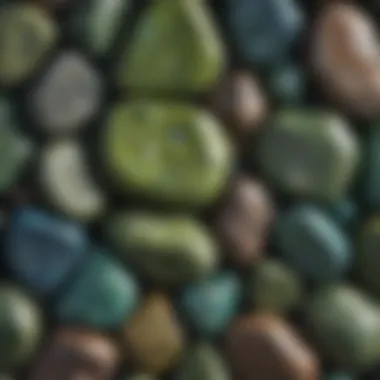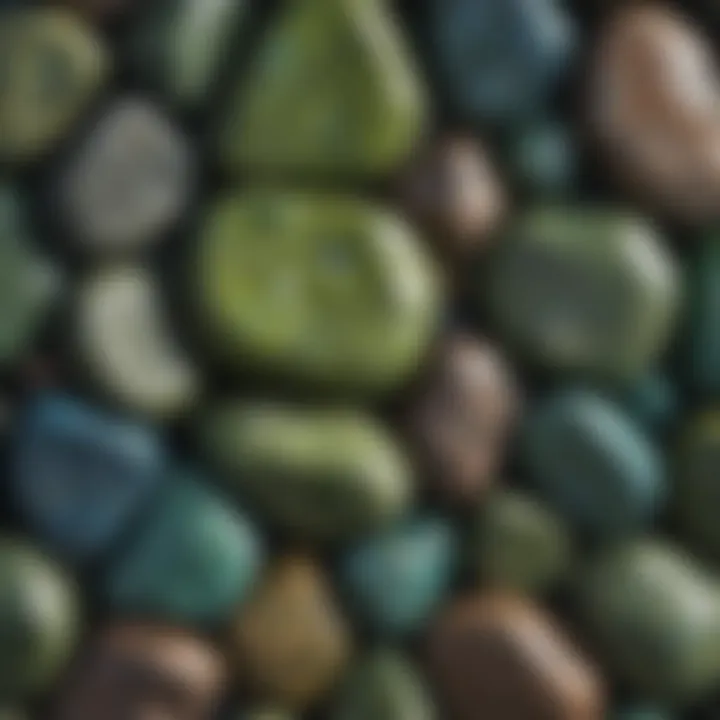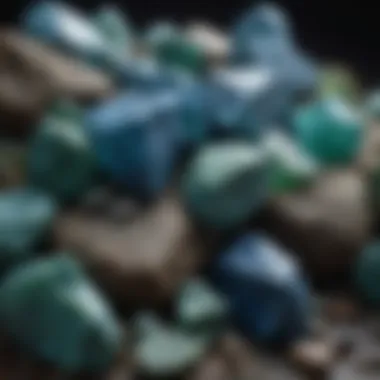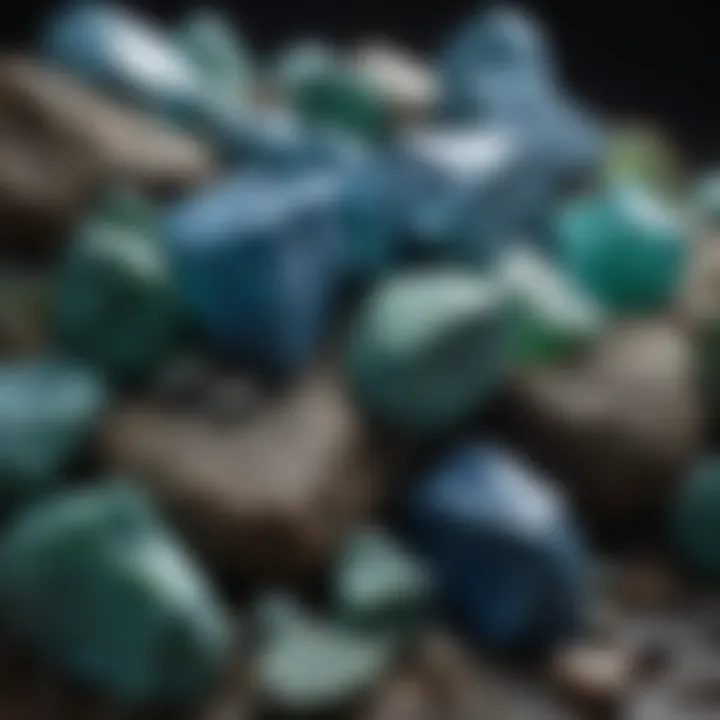Exploring the Beauty and Significance of Blue and Green Rocks


Intro
The vibrant hues of blue and green rocks have fascinated humanity for centuries. From the shimmering depths of the ocean to the lush landscapes of our planet, these striking colors capture our imagination and stir our deepest curiosities. As collectors, enthusiasts, and scholars delve into the geological and cultural dimensions of these rocks, one cannot help but marvel at their unique formations and the stories they tell about Earth's history.
In this exploration, we will not only discover the science behind these colors but also unveil their significance in various cultures. Whether you are a seasoned collector or a curious novice, understanding these captivating rocks will deepen your appreciation for nature's artistry.
History and Origins
Overview of Collectibles, Rocks, and Fossils
Throughout history, blue and green rocks have been sought for their beauty and rarity. Gemstones such as lapis lazuli, turquoise, and jade have carved out their legacies as coveted treasures. Much like art, these stones possess inherent values, shaped by the market, cultural backgrounds, and personal preferences. Collectors often realize that certain rocks can offer not just aesthetic appeal but also a glimpse into geological processes and ancient histories.
The allure extends beyond artistic expression into the practicalities of geology and mineralogy. Collectible rocks can range from the common to the exceedingly rare, and their classifications provide an enriching layer to the allure.
Historical Significance and Cultural Impact
From ancient civilizations to modern societies, blue and green rocks have served diverse purposes. In ancient Egypt, turquoise was renowned not just for its beauty, but was also considered a protective talisman. Meanwhile, lapis lazuli held such high esteem that it was often ground into powder for use in artworks, giving life to the rich blues seen in many historical paintings.
Cultural practices continued through the ages, particularly in jewelry making, where jade has been regarded as a symbol of purity and moral integrity in various Asian cultures. In the Americas, the pre-Columbian societies valued turquoise not only for adornment but also for its alleged healing powers. These cultural narratives remind us that blue and green rocks are more than mere collectibles; they are intertwined with human stories and aspirations.
"The beauty of blue and green rocks transcends mere aesthetics; they are part of the fabric of human culture and history."
As we navigate through the geological formations that yield these colorful rocks, it becomes apparent that their captivating essence arises from complex atomic arrangements and chemical reactions. Let’s carry on to explore how these rocks are identified and classified, each step taking us deeper into understanding their unique attributes.
Intro to Blue and Green Rocks
Rocks possessing vibrant hues of blue and green are not merely visually appealing but significantly enrich the geological tapestry of our planet. This introduction sets the stage for understanding the multiple layers of meaning embedded in these stones. Particularly for collectors and nature enthusiasts, grasping the essence of blue and green rocks opens a gateway to deeper appreciation, both scientifically and culturally.
The colors we see in these rocks arise from a confluence of chemical processes and mineral compositions. A stunning blue can be attributed to minerals like lapis lazuli or azurite, while a lush green may sprout from malachite or jadeite. These are far from just pretty façades; understanding their origins can reveal insights into the Earth's history, including environmental conditions that existed eons ago.
Exploring blue and green rocks offers practical benefits as well. They present collectors with unique challenges: distinguishing genuine minerals from imitations, discerning variations in quality, and evaluating value based on rarity.
By the end of this article, readers will not only identify notable examples but also understand the geological processes behind their formation, get a grasp on their cultural significance, and learn crucial tips for acquiring and preserving these extraordinary specimens.
Defining Blue and Green Rocks
In the world of geology, defining blue and green rocks encompasses a variety of minerals that exhibit vibrant shades primarily caused by specific atoms and compounds. Fundamentally, these colors arise from the way light interacts with mineral structures.
For instance, lapis lazuli, renowned for its deep cerulean color, is primarily made up of lazurite, with calcite and pyrite adding to its visual allure. On the flip side, malachite is characterized by its striking green stripes and is largely composed of copper carbonate. Each variant offers a unique palette from nature's canvas, creating a specific identity for these rocks.
It's important to realize these colors are not merely aesthetic; they often signify particular environmental conditions and geological histories. Blue and green shades frequently indicate the presence of specific elements like copper for greens or sulfur in blues. As a collector, recognizing these identifiers can unfold a broader narrative about each specimen's origin and journey.
Importance in Geology and Collecting
In the realm of geology, blue and green rocks illustrate phenomena much grander than mere mineral deposits. They serve as geographic markers, potentially indicating the conditions under which they formed, such as the temperature, pressure, or chemical environment.
From a collecting standpoint, these rocks are prized not just for their beauty, but also their rarity. High-quality specimens can fetch astronomical prices, establishing demand not only among hobbyists but also serious investors. Their uniqueness—with different rocks exhibiting distinct textures, colors, and translucency—invites collectors to build comprehensive collections.
"The pursuit of blue and green rocks is not just about ownership; it's about connecting with the Earth's history and understanding its underlying stories."
Given their significance, collectors often participate in networking communities and forums, sharing insights about how to identify authentic materials and discussing evaluations in quality and price. Engaging in these communities strengthens both the knowledge pool and the appreciation for these remarkable geological artifacts.
Thus, whether one is scientifically inclined or simply enamored by the aesthetic appeal, blue and green rocks stand as pillars of exploration, deserving of careful study and reverence in the collecting community.


Color Indicators in Rocks
Understanding the color indicators in rocks is essential for anyone keen on geology, mineralogy, or simply collecting beautiful specimens. Colors are not just mere decorations; they provide insights into the mineral composition and geological history of the rocks. In the case of blue and green rocks, these hues can reveal a lot about their formation processes and the environments in which they were created.
Often, the vibrant colors seen in minerals can be an attractive lure, leading collectors to acquire certain pieces for their striking appearance. However, knowing how and why these colors present themselves in rocks drastically enhances the appreciation of these geological marvels. By examining color indicators, collectors and enthusiasts can better understand what they possess and what significance these specimens might hold.
The Science Behind Color in Minerals
Delving into the science of mineral color, we uncover that the hues we observe are the result of various factors, including light absorption and reflection. For instance, minerals can possess certain ions or chemical groups that interact with light in unique ways. Take azurite, whose deep blue color results from the absorption of light at specific wavelengths due to the presence of copper ions.
When light strikes these minerals, some wavelengths are absorbed while others are reflected. This selective absorption leads to the color we perceive. For instance, the deep blue of lapis lazuli comes from the intricate mix of minerals it contains, particularly lazurite, which plays a crucial role in determining its shade. Thus, colors in rocks serve as a window into their chemical makeup and historical environments.
"Color in minerals is not just skin deep; it tells most of the geological story beneath the surface."
How Mineral Composition Affects Color
The mineral composition is paramount in determining the color of a rock. Different minerals exhibit their distinct characteristics based on their chemistry and structure. For example, chlorite minerals give a classic green hue, while azurite and lapis lazuli contribute blue tones,
Some minerals are known to reveal vibrant colors due to trace elements. For example, a touch of chromium in an otherwise ordinary mineral can turn it into a green masterpiece. Similarly, iron can impart a lovely shade of blue or green, depending on its oxidation state. This is crucial for collectors to recognize—the subtleties in mineral composition not only affect color but can also hint at the rock’s overall rarity and value.
When identifying blue and green rocks, consider these aspects of composition. It makes it easier to seek out unique pieces that tell a story about their origins and the conditions under which they formed. From metamorphic conditions to igneous activity, mineral composition stands at the crossroads of color and geological significance, inviting collectors to dig deeper into their collections.
Notable Examples of Blue and Green Rocks
The colors blue and green are not just hues but evoke emotions, symbolize tranquility, and offer insights into the nature of the minerals from which they derive. When we look at notable examples of blue and green rocks, we're set to discover the stories, geological journeys, and cultural significance that lend these minerals their allure. Diving into the characteristics of these specimens opens a window into the processes that forge them and the aesthetic value they bring to collections.
Lapis Lazuli: The Royal Blue Gemstone
Lapis Lazuli is often hailed as the epitome of blue gemstones, captivating enthusiasts for centuries. Known for its rich, deep blue color speckled with golden pyrites, it commands a regal presence. Once reserved for royalty and the elite, Lapis Lazuli carries a historical weight that adds to its desirability.
This gemstone originated from the ancient mines in Afghanistan, where its formation is closely tied to metamorphic processes. The intense blue of Lapis Lazuli primarily comes from the presence of lazurite, a complex mineral within its composition. Its enduring significance in art and jewelry cannot be overstated—historically, it was ground into powder to create ultramarine, a pigment sought after by painters to add luminosity to their work.
"Lapis Lazuli, when worn, does not merely adorn; it tells a story of civilizations lost, reverberating through time."
Malachite: A Green Marvel of Nature
Malachite stands out not just for its vibrant green coloration, but for the stunning banded patterns that adorn its surface. Found primarily in copper deposits, the rich hues of green arise from malachite's unique copper carbonate composition. The mineral has been utilized since antiquity, serving various purposes—ranging from ornamental carvings to healing gemstones.
Part of Malachite's allure is the way it can be polished and carved into intricate designs. It has gained recognition among collectors for these very attributes, offering a natural beauty that transcends simple geological interest. Enthusiasts often admire it not just for its aesthetic value but for the symbolic associations it carries, often linked to prosperity and nurturing.
Other Significant Specimens
In addition to Lapis Lazuli and Malachite, there are several other notable blue and green rocks worthy of exploration.
Azulite
Azulite presents a vibrant azure blue, earning it a position of esteem among collectors. This mineral, often found in clusters, is tapped for its grounding and stabilizing qualities. An interesting aspect of Azulite is how its color appears different at various angles, often captivating viewers. While not as widely known as Lapis Lazuli, it has carved a niche thanks to its rarity and the beautiful aesthetic it adds to rock collections.
Aventurine
Aventurine, with its shimmering green appearance, is a quartz-rich stone that has enthralled many for its supposed luck-bringing properties. The presence of mica inclusions gives it a sparkling effect, often leading to its nickname "the stone of opportunity." Collectors appreciate Aventurine not only for its physical charm but also for its versatile use in everything from jewelry to carvings. However, it may seldom reach the same prestige as its more illustrious counterparts, yet its accessibility renders it appealing for those beginning to explore the world of valuable minerals.
Chrysocolla
Chrysocolla might not overshadow gems like Lapis Lazuli but its soft, teal-blue to green shades catch the eye of many. This mineral forms in copper deposits, often exhibiting beautiful patterns reminiscent of watercolor paintings. Its allure lies in the tranquility the color evokes and its connection to emotional healing. While Chrysocolla may lack the hardness and durability of some other gems, its unique visual appeal makes it a sought-after specimen for rock enthusiasts looking to add depth to their collection.
The exploration of these notable examples underscores the diverse spectrum of blue and green rocks. Each tells its own tale, connecting geology with culture and personal expression. Collectors can appreciate not only their aesthetic contributions but also the stories woven into their history.
Geological Processes and Environments


The realm of blue and green rocks cannot be fully understood without delving into the geological processes and environments that give rise to their stunning hues. Each formation process plays a crucial role in defining the characteristics and attributes of these rocks. Furthermore, understanding these processes lends insights to collectors and enthusiasts about the stories held within each specimen.
Formation Processes of Blue and Green Rocks
Blue and green rocks stem from various geological processes. These processes are not just mundane explosions or slow formations but intricate dances of nature's elements and temperature swings. Each color, from the deep cerulean of lapis lazuli to the vibrant greens of malachite, is a result of specific mineral compositions and organic interactions over millennia. The various ways these rocks form can shape their history, rarity, and desirability for collectors.
Significant Geological Environments
The environments in which blue and green rocks form are part and parcel of their allure. Here, we examine three significant settings: metamorphic, igneous, and sedimentary. Each offers unique pathways through which these colorful minerals can evolve.
Metamorphic Settings
In metamorphic settings, rocks are altered through intense pressure and temperatures, often leading to unexpected transformations. It's in these high-stakes conditions that certain minerals are forced to crystallize into stunning varieties that sport rich blue and green hues. This metamorphism also allows for complex interactions between different mineral types, enriching the color palette further.
The key characteristic here is the adaptability of minerals under stress, which enhances their color and structure. For instance, the transformation of limestone into marble can introduce stunning green tints depending on the impurities present during the process. However, while metamorphic environments can produce exquisite pieces, they also tend to be rare, making the hunt for authentic specimens all the more intriguing.
Igneous Activity
Igneous rocks form from the cooling magma and lava, often yielding vibrant colors as different minerals crystallize at varying temperatures. Blue and green hues can arise from specific alterations in mineral makeup during these cooling processes. An essential aspect of this activity is the rapid cooling of lava, which leads to the formation of unique minerals that can contain copper, leading to that captivating turquoise shade.
Igneous formations are generally more widespread and accessible than metamorphic ones, giving collectors a fair chance to find striking samples. The downside, though, is that collecting igneous rocks often requires an understanding of volcanic activity and the specific locations of past eruptions, adding layers of complexity to the collecting experience.
Sedimentary Formation
Sedimentary rocks are formed from the accumulation of fine particles over time. This includes materials from weathered rock, organic matter, and sometimes even mineral precipitates. The blue and green tones often emerge through processes like the concentration of specific minerals during sediment deposition. This means that understanding past environmental conditions can provide significant insight into a rock's origin story.
One of the inherent strengths of sedimentary deposits is their ability to record the history of earth's atmospheres. This makes them appealing not only to collectors but also to scientific communities interested in paleoenvironmental studies. However, the variability in sediment sources may affect the consistency of colors, leading to a mixed bag in terms of perceived quality or value among collectors.
"Exploring the geological processes behind blue and green rocks not only deepens appreciation for their beauty but also enriches our understanding of the planet's history."
Grappling with the complexities of these environments, collectors find profound engagement not merely in the aesthetics of these rocks but also in the rich narratives they encase. The journey through metamorphic, igneous, and sedimentary formations unravels a tapestry of Earth’s evolutionary wonders, making every piece of blue and green rock akin to a chapter in the story of our planet.
Collecting Blue and Green Rocks
Collecting blue and green rocks isn't just a pastime; it's a passion steeped in history, art, and science. The vibrant hues of lapis lazuli, the rich greens of malachite, and other stones ignite a spark in collectors and enthusiasts. These colors, beyond their aesthetic appeal, tell stories of the Earth’s history, its processes, and the diverse environments in which these specimens are formed.
While many may dabble in the world of rock collecting, serious enthusiasts understand the nuances that make each piece unique. The thrill of discovery—whether at a gem fair, a local rock shop, or while out in the wild—fuels this hobby. Collectors often form personal connections to their specimens, seeing them as not just objects, but as embodiments of the natural world's magnificence and variety.
Moreover, as globalization brings various cultures and collectors together, it opens up avenues for learning about the different historical uses and significance of these stones. This cross-pollination of ideas enriches the collecting experience and fosters a broader appreciation for these geological artifacts.
Identifying Authentic Specimens
Identifying authentic blue and green rocks is a crucial skill for any serious collector. Knowledge is power in this realm, and knowing how to distinguish between genuine specimens and imitations can save both money and heartache.
One of the first tips is to understand the visual characteristics of the stones you're interested in. For instance, lapis lazuli typically exhibits specks of golden pyrite; if it appears uniform without any variation, it's likely fake. Similarly, malachite shows banding patterns that are distinctive. Using good lighting to scrutinize the rock can reveal these telltale signs.
Additionally, tactile examination plays a big role. Authentic gemstones often feel cool to the touch due to their density, while plastic imitations may feel warmer or lighter. Another approach is the hardness test: a genuine malachite, for example, is less hard than glass, meaning it can be scratched by it.
A reliable way to confirm authenticity is through professional appraisal. Many rock enthusiasts build relationships with gemologists who can help confirm the legitimacy of a specimen, ensuring the integrity of one’s collection.
Evaluating Rarity and Value
Evaluating the rarity and value of blue and green rocks isn't a simple affair. Several factors come into play that can affect both. Understanding these factors equips collectors with the ability to make informed decisions when buying or selling their pieces.
Firstly, the source of the rock significantly influences its worth. For example, a piece of lapis lazuli from Afghanistan is considered more valuable than one sourced from elsewhere due to its storied history and unique color depth.
Another factor is the condition of the specimen. Chips, scratches, or discoloration can drastically reduce value. Collectors often prefer pieces that are not only visually striking but also preserved well.
Rarity often drives up prices; thus, knowledge of how common or scarce certain stones are plays a pivotal role in evaluation. Limited availability can create demand and elevate prices, so keeping abreast of market trends through resources like dedicated forums and collector magazines is beneficial.
Finally, provenance adds to value as well. A rock that has a notable background, such as being part of a prominent collection, tends to carry a higher price tag. Simple Google searches or exploring platforms like reddit.com can help in tracking this kind of information.


Caring for Your Collection
Caring for blue and green rocks is paramount for preserving their beauty and integrity. It may seem straightforward, but there’s an art to ensuring these specimens remain in optimal condition.
One of the primary considerations is cleaning. It’s vital to avoid harsh chemicals that might scratch or damage the surface. Instead, gently wash your rocks with warm, soapy water and a soft cloth. For more delicate stones, like azurite and turquoise, opt for a damp cloth instead of submerging them.
Storage is equally essential. Keeping your rocks in a humidity-controlled environment can prevent deterioration. Consider using display cases with UV protection to avoid color fading, particularly for those vibrant blues and greens.
It’s also wise to handle specimens with care. Use cloth gloves when transferring them, as oils from your skin could potentially lead to gradual wear.
"Taking simple steps to care for your collection not only prolongs its life but also enhances its beauty for years to come."
In essence, collecting blue and green rocks transcends mere acquisition; it invites a deeper appreciation of Earth's artistry and history. Armed with the right knowledge and skills, enthusiasts can build exquisite collections that not only symbolize personal passion but also carry tales of the planet’s geological wonders.
Cultural Significance of Blue and Green Rocks
The cultural significance of blue and green rocks is extensive, extending across different societies and historical periods. Beyond their stunning appearances, which can captivate and draw the eye, these geological specimens have often played pivotal roles in the rituals, traditions, and daily lives of people around the globe. When we look closely at their historical uses, as well as their modern associations, we gain insight into how these stones have woven themselves into the fabric of human culture.
Historical Uses and Symbolism
Throughout history, blue and green rocks have been revered for their beauty and rarity, leading to their incorporation into various cultural practices. For instance, lapis lazuli, with its vibrant blue hue often likened to the midday sky, was not just admired for its visual appeal. In ancient civilizations such as Mesopotamia and Egypt, it was considered a powerful symbol of royalty and wisdom. The stone was ground into powder to create a pigment used in artwork and was embedded in jewelry that adorned the elite.
Similarly, malachite, known for its rich green layers, has been utilized since antiquity. It was often used in amulets and talismans, believed to protect wearers from misfortune. Ancient Egyptians used it as a pigment in their paints and cosmetics, and its vibrant color was associated with fertility and renewal.
Moreover, both of these rocks not only served functional purposes but also carried deep spiritual meanings. Lapis lazuli was seen as a bridge to the divine, while malachite was thought to have healing properties, bringing balance and harmony.
"In every stone lies a piece of history, waiting for the curious to uncover its story."
Present-Day Cultural Associations
In contemporary society, the allure of blue and green rocks does not wane; rather, it evolves. Collectors and enthusiasts approach these stones not only for their aesthetics but for the meanings imbued in them by history and culture. The wellness industry has adopted these stones for their purported metaphysical properties, marketing them as tools for meditation and energy healing.
For example, many believe that wearing lapis lazuli enhances intellectual capabilities and encourages self-awareness. To some, it also represents truth and inner power. Meanwhile, malachite is often linked to emotional balance and transformation, making it a popular choice for those seeking personal growth.
In art and fashion, blue and green stones are heralded as symbols of sophistication and class. The visually striking nature of these rocks can often be seen in high-end jewelry and home decor pieces, elevating the ambiance in any space. Furthermore, social media platforms, such as Facebook and Reddit, are filled with communities dedicated to the appreciation and discussion surrounding these rocks, which fosters an ongoing cultural dialogue that connects enthusiasts worldwide.
In summary, the historical and present-day significance of blue and green rocks is woven deeply into various cultural narratives. As we explore their past and present, we reveal not just the appeal of their colors, but also the profound roles they continue to play in human expression and experience.
The Future of Collecting Blue and Green Rocks
The future of collecting blue and green rocks is not just about amassing beautiful specimens; it represents a confluence of passion, knowledge, and ecological responsibility. As collectors, there’s a meaningful opportunity to delve into not only the aesthetic allure but also the ethical implications surrounding the practice of collecting these geological treasures. With the rising awareness of environmental issues and sustainable practices, collectors must evolve their perspective on how they approach sourcing these rocks.
Exploring the trends that shape the collecting community unveils a landscape where tradition meets innovation. The increasing accessibility of information via social media platforms and online forums fosters a camaraderie among enthusiasts. Collecting blue and green rocks can transition from a solitary activity to a vibrant community involvement. It poses a challenge, though: how will these changes affect the environment and the minerals we cherish?
Emerging Trends in the Collecting Community
The collecting community is changing rapidly, propelled by new sourcing avenues and technology. A few trends stand out:
- Digital Collecting: Online marketplaces have expanded the reach of collectors. Now, enthusiasts can purchase specimens from all corners of the globe. However, this convenience comes with the need for caution, as verifying authenticity becomes paramount. Buyers must develop skills to discern real stones from imitations.
- Social Media Engagement: Platforms like Instagram and Reddit allow collectors to showcase their finds, share tips, and connect with like-minded individuals. These spaces cultivate a sense of belonging and inspire people to expand their collections thoughtfully.
- Focus on Local Collecting: An increasing number of collectors favor discovering local specimens. This trend not only emphasizes the importance of community but encourages sustainable practices that minimize the carbon footprint associated with transporting rocks from distant locales.
- Educational Workshops: More organizations are hosting workshops aimed at both novices and seasoned collectors. These gatherings promote skill-sharing and deepen the understanding of rock geology, thus enriching the collecting experience for everyone involved.
Each of these trends highlights the value of knowledge and community in the collecting ethos. As the landscape evolves, it's crucial for collectors to stay informed and engage responsibly.
Environmental Considerations in Mining
As long as there’s demand, the mining and extraction of materials will flourish. This brings a silver lining but also darker clouds. The consequences of mining practices can be dire, impacting ecosystems and communities. Therefore, collectors should consider these factors:
- Sustainable Practices: It’s vital to support sources that adhere to eco-friendly mining procedures. Organizations that prioritize sustainability help mitigate the negative effects associated with extraction activities. By buying from reputable sellers who show transparency, collectors can play a part in responsible sourcing.
- Reclamation Efforts: An often-overlooked detail is the importance of reclamation. After mining companies finish extracting minerals, rehabilitating the affected landscapes is crucial. Collectors should be aware of how companies handle post-mining environments and choose to support those committed to restoring the land.
- Community Impact: The local populations around mining sites are directly affected. Understanding the socioeconomic dynamics at play can better inform a collector's purchasing decisions. Supporting local economies should be part of the responsible collecting ethos.
Understanding the interplay between collection and environment illustrates why responsible practice is critical for future generations. Collectors are not merely hobbyists; they are stakeholders in the preservation of natural resources.
In summary, the future of collecting blue and green rocks hinges on our decisions today. As the community grows, let’s prioritize knowledge, community, and sustainability to preserve the beauty of our earthly treasures.



